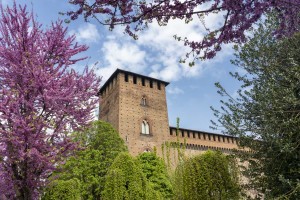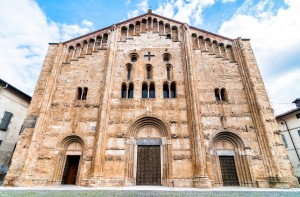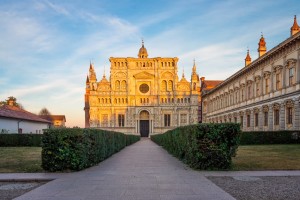
©Bigstock.com/Claudiogiovanni
City tourists probably wouldn’t call Pavia their number one address, but history buffs most certainly cannot get enough of it. After all, this is where the Western Roman Empire ended before the town in southwestern Lombardy would eventually become a centre of science and art. Don’t sleep on the architectural diversity of Pavia with plenty of astounding Romanesque and Gothic sights – the perfect backdrop for highly indulging tours between historic walls and charming cafés. Strap in, it’s time to dive deep into Pavia!
Where the Western Roman Empire ended
Ancient scholars offer different theories as to Pavia’s exact origins. Pliny the Elder believed the town was founded by two Ligurian tribes, while Claudius Ptolemy names the Celtic Insubres. It was an important Roman military site, then known as Ticinum, and grew bigger and bigger over time. The Western Roman Empire effectively ended here when the last emperor Romulus Augustulus was dethroned in 476 AD. Pavia would eventually become the Lombard capital after a three-year siege. It took even Charlemagne nine months (between 773 and 774) to capture the town. Hungarian raids and citizen revolts in later centuries were bloodily suppressed.
Pavia mostly had a symbolic meaning during the Holy Roman Emperor before becoming one of the most important Italian towns in later centuries. The Visconti, rulers of Milan, captured Pavia after a long siege in 1359 and turned it into the Northern Italian centre of science and art. The university was opened only two years later. French troops conquered the town for several months during the Italian Wars of the 16th century. The king’s defeat and capture in the Battle of Pavia in 1525 is one of the key events of the early modern age. Pavia had Spanish, Austrian and Napoleonic rulers in later centuries before eventually being incorporated into the newly founded Kingdom of Italy in 1860.
Romanesque Pavia

©Bigstock.com/elesi
One of the architectural aspects that makes Pavia so exciting is the fairly distinct division of most sights into two different main eras with a few other select highlights attributed to later periods. Our first “stop”, if you will, leads us to the Romanesque with buildings that mainly date back to the Carolingian rule and the Holy Roman Empire.
- San Michele Maggiore: A dispute over the Italian crown lead to the destruction of the preceding Lombard church by the flames of the revolting masses in the early 11th Today’s basilica was initially built around 100 years later before being immediately destroyed by a severe earthquake. San Michele Maggiore was finally completed on 15 April 1155, just in time for the crowning of Emperor Frederick Barbarossa. Lombard and Romanesque architecture come together here. The sandstone basilica is widely regarded as the epitome of regional medieval church architecture.
- San Pietro in Ciel d’Oro: There are many parallels between San Pietro and San Michele Maggiore. A church had already existed there previously, it was built after the crown controversy, and the earthquake mentioned above caused severe damages. A glorious basilica with the namesake golden relief on the apse ceiling is hidden behind the fairly plain brickwork façade. San Pietro in Ciel d’Oro is probably best known for the tombs of the philosopher Boethius, of Saint Augustine, and of the Lombard king Liutprand.
- San Teodoro: The third Romanesque basilica also has Lombard roots. Built in honour of the eponymous patron saint of Pavia, it combines the era’s simplicity with spectacular frescoes depicting the town from bird’s eye view.
- The towers: There were around 50 tower houses in 12th century Pavia, all built by influential families for defensive and residential purposes. Three “survived” as free-standing towers while the remnants of others were incorporated into houses. The astounding Torre Civica, former site of the cathedral bells, sadly collapsed in 1989.
Gothic Pavia

©Bigstock.com/Robik70
Time to jump to the next era. The townscape changed after the Visconti from Milan rose to power in Pavia. Numerous Gothic buildings were constructed. They remain impressive to this very day:
- Certosa di Pavia: Your first point of interest, so to say, should be Pavia’s most renowned building. Gian Galeazzo Visconti, the first Duke of Milan, had a monastery built in his castle’s park and saw to it that he would be buried there later. The enormous monastic complex of the Certosa is Gothic at its core yet also features Renaissance and baroque elements. You can view the Carthusian charterhouse every day except on Mondays and experience the colourful paintings as well as the numerous tombs.
- Santa Maria del Carmine: This epitome of Lombard Gothic architecture even utilises a touch of the Romanesque for its slender façade. Six pilasters with spires, several portals and an enormous rose window adorn this brickwork building.
- Castello Visconteo: Gian Galeazzo’s father Galeazzo II had a castle built for himself that emphasised residential qualities over defensive use. It currently serves as the home of several civic museums including a huge art gallery plus Risorgimento and archaeological museums.
- San Francesco d’Assisi: Many of Pavia’s Romanesque churches are of Lombard origin. However, in a fairly neat twist, this is a Romanesque building that was adapted for Gothic use. The Franciscan church with its impressive façade might remind you a little bit of Santa Maria del Carmine.
- Ponte Coperto: From an adaptation to a reconstruction – the 14th century saw the erection of the Gothic bridge connecting the historic centre with the district Borgo Ticino. Having been destroyed during the Second World War, it was rebuilt a few metres to the east.
Even more things to see in Pavia
Well, is that enough Pavia for you? No? Awesome, because we have a few more neat suggestions for your next visit in store:
- Duomo di Pavia: The predecessors might be Romanesque, its origins are Gothic, but the cathedral can look back on a rather eventful construction history exceeding 400 years. As such, you get to expect a wide stylistic plurality. Built on the plan of a Greek Cross, you cannot help but marvel at the astounding cupola. It is 97 metres high, weights approx. 20,000 tons and has 34 windows. The only Italian churches with bigger cupolas are St. Peter’s Cathedral in Rome and Santa Maria del Fiore in Florence.
- University: Despite having been founded in 1361 making it one of the oldest in all of Europe, the main building complex of the University of Pavia was only added and adapted much later during several construction periods. Twelve courts with façades ranging from baroque to neoclassic were built between 1534 and 1850. The university is both a centre of knowledge and a genuinely special sight with ancient burial monuments of scholars, terracotta decorations and Renaissance elements.
- Santa Maria di Canepanova: You will hardly be surprised to learn that Pavia has a Renaissance church as well. Santa Maria di Canepanova was designed by Giovanni Antonio Amadeo. His credits include Milan Cathedral. He adapted the ad quadratum style of Bergamo’s Cappella Colleoni for this building.
As you can see, there’s more to Pavia than “just” its historic significance. You get to experience many a hidden treasure, as you do in a genuine city of arts. Retrace the steps of renowned and feared rulers, and let the seamless transition from Romanesque to Gothic wash over you. Pavia is always worth the trip.